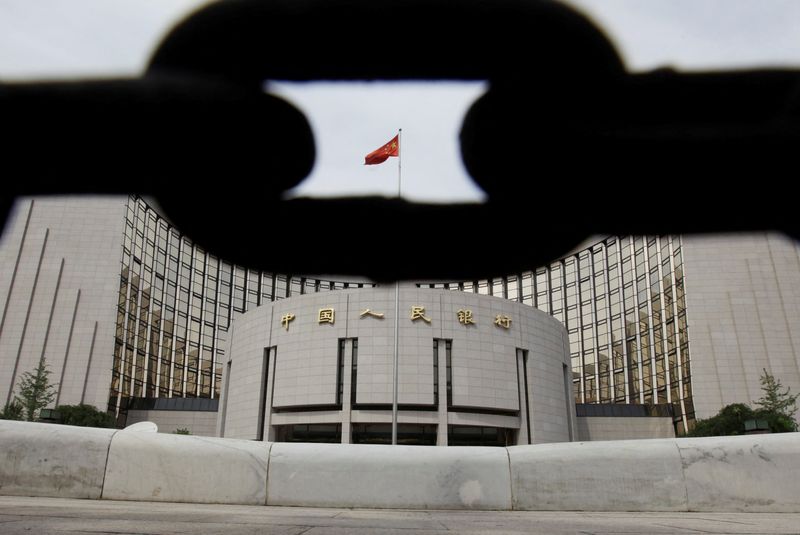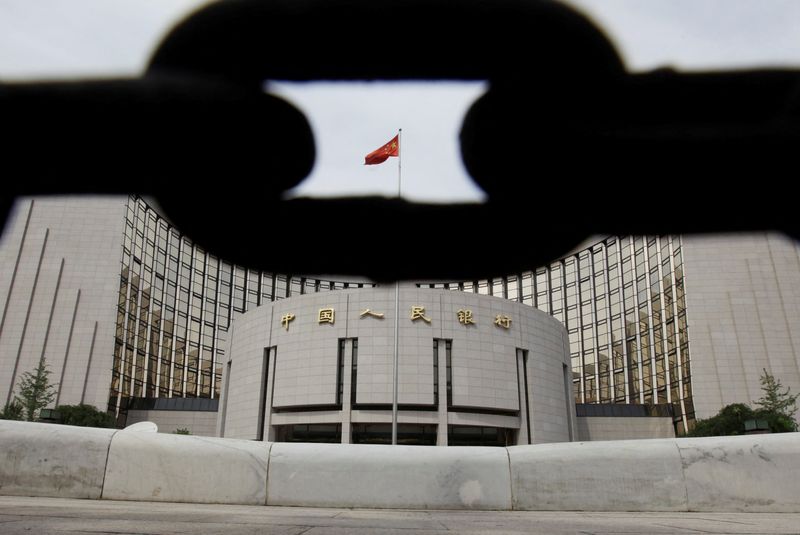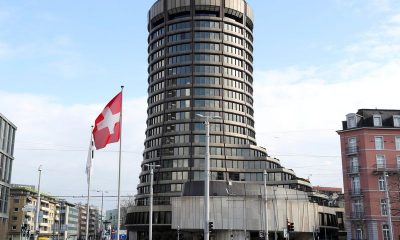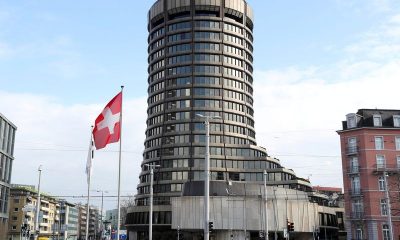Economy
China’s choice of PBOC party chief signals financial stability worries


© Reuters. FILE PHOTO: The headquarters of the People’s Bank of China, the central bank, is pictured behind an iron chain in Beijing August 30, 2010. REUTERS/Jason Lee/File Photo
By Kevin Yao
BEIJING (Reuters) – China’s appointment of financial technocrat Pan Gongsheng to a top political post at the central bank points to growing concerns within the country’s leadership over systemic risks in its sprawling financial sector, policy insiders and analysts said.
Pan, who came to prominence fighting capital outflows, will be in position to take over the top job at the People’s Bank of China (PBOC) when Governor Yi Gang steps down, two policy sources told Reuters.
The central bank did not immediately respond to Reuters’ request for comment.
Pan, central bank deputy governor since 2012 who turns 60 this month, is not expected to deviate from China’s measured pace of policy easing to support the recovery, analysts said. He has forged a reputation as a risk averse central banker, playing a key role in enforcing several crackdowns on perceived financial threats in the past decade.
His appointment comes as China tries to ward off major challenges to its financial stability from about $9 trillion of local government debt and a downturn in the property sector, which accounts for roughly a quarter of economic activity.
“He will be able to implement key financial policies from the top to cope with economic uncertainties,” said a source involved in policy discussions who preferred not to be identified due to the sensitivity of the matter.
“His professional ability will help safeguard the bottom line of systemic financial risks, especially as the property sector is slowing, and fend off a big systemic crisis.”
In 2016, Pan also took on the role of China’s top foreign exchange regulator, managing the world’s largest foreign exchange reserves of around $3.2 trillion.
He is known for taking a tough stance against currency speculators and was also involved in state banking reforms, tightening property market and fintech regulations, and in banning cryptocurrencies.
In a speech in late May, Pan spoke at length about preventing and resolving financial risks as an “eternal theme,” calling for better coordination between regulators in the context of a “complex and ever-changing external environment.”
It is not immediately clear how Pan will look to make an impact, but PBOC watchers expect him to steer policy to support the economy, even as the central bank has limited room to manoeuvre, and use its macro-prudential rules to curb risks.
“Pan’s appointment will help maintain policy continuity and stability, as we face pressures internally and externally,” said Gu Tianyong, an influential economist at the Central University of Finance and Economics in Beijing.
In an unexpected move, the ruling Communist Party appointed Pan as the central bank’s party secretary on Saturday, taking over from Guo Shuqing. The Wall Street Journal, citing people familiar with the matter, said the move was a prelude to replacing Yi.
Yi’s predecessor Zhou Xiaochuan also held the governor and party secretary roles simultaneously.
If confirmed, Pan, who did post-doctoral research at Cambridge University and was a senior research fellow at Harvard University, will have a consolidated position of power, albeit in an institution reporting into new regulators.
China has taken a series of steps this year to tighten party control over the country’s vast, but largely closed, financial system, including plans to set up the Central Financial Commission to oversee the PBOC and other financial regulators.
Zhou and Yi introduced pro-market reforms during their mandates, but the new structure limits PBOC’s policymaking abilities and fits better with Pan’s focus on risks, analysts said.
MEASURED EASING
The world’s second-largest economy, under an overall debt burden of three times its output, is struggling to gain momentum due to waning external demand and its failure to lift household consumption, a long-standing weak spot.
But on monetary policy, risk-wary Pan is seen likely to support the current path of measured easing steps.
“We need to consider how to stimulate the economy, but we should first make sure risks are under control,” said a second policy insider.
The PBOC cut its benchmark interest rates for the first time in 10 months in June by a modest 10 basis points, and further easing measures in coming months are expected to be similarly restrained, especially as credit demand remains subdued.
“The room for monetary policy easing is limited and the effectiveness faces many constraints,” said Xu Hongcai, deputy director of the economic policy commission at the state-backed China Association of Policy Science.
Economy
Russian central bank says it needs months to make sure CPI falling before rate cuts -RBC


© Reuters. Russian Central Bank Governor Elvira Nabiullina attends a news conference in Moscow, Russia June 14, 2019. REUTERS/Shamil Zhumatov/File Photo
MOSCOW (Reuters) – Russia’s central bank will need two to three months to make sure that inflation is steadily declining before taking any decision on interest rate cuts, the bank’s governor Elvira Nabiullina told RBC media on Sunday.
The central bank raised its key interest rate by 100 basis points to 16% earlier in December, hiking for the fifth consecutive meeting in response to stubborn inflation, and suggested that its tightening cycle was nearly over.
Nabiullina said it was not yet clear when exactly the regulator would start cutting rates, however.
“We really need to make sure that inflation is steadily decreasing, that these are not one-off factors that can affect the rate of price growth in a particular month,” she said.
Nabiullina said the bank was taking into account a wide range of indicators but primarily those that “characterize the stability of inflation”.
“This will take two or three months or more – it depends on how much the wide range of indicators that characterize sustainable inflation declines,” she said.
The bank will next convene to set its benchmark rate on Feb. 16.
The governor also said the bank should have started monetary policy tightening earlier than in July, when it embarked on the rate-hiking cycle.
Economy
China identifies second set of projects in $140 billion spending plan


© Reuters. FILE PHOTO: Workers walk past an under-construction area with completed office towers in the background, in Shenzhen’s Qianhai new district, Guangdong province, China August 25, 2023. REUTERS/David Kirton/File Photo
SHANGHAI (Reuters) – China’s top planning body said on Saturday it had identified a second batch of public investment projects, including flood control and disaster relief programmes, under a bond issuance and investment plan announced in October to boost the economy.
With the latest tranche, China has now earmarked more than 800 billion yuan of its 1 trillion yuan ($140 billion) in additional government bond issuance in the fourth quarter, as it focuses on fiscal steps to shore up the flagging economy.
The National Development and Reform Commission (NDRC) said in a statement on Saturday it had identified 9,600 projects with planned investment of more than 560 billion yuan.
China’s economy, the world’s second largest, is struggling to regain its footing post-COVID-19 as policymakers grapple with tepid consumer demand, weak exports, falling foreign investment and a deepening real estate crisis.
The 1 trillion yuan in additional bond issuance will widen China’s 2023 budget deficit ratio to around 3.8 percent from 3 percent, the state-run Xinhua news agency has said.
“Construction of the projects will improve China’s flood control system, emergency response mechanism and disaster relief capabilities, and better protect people’s lives and property, so it is very significant,” the NDRC said.
The agency said it will coordinate with other government bodies to make sure that funds are allocated speedily for investment and that high standards of quality are maintained in project construction.
($1 = 7.1315 renminbi)
Economy
Russian central bank says it needs months to make sure CPI falling before rate cuts -RBC


© Reuters. Russian Central Bank Governor Elvira Nabiullina attends a news conference in Moscow, Russia June 14, 2019. REUTERS/Shamil Zhumatov/File Photo
MOSCOW (Reuters) – Russia’s central bank will need two to three months to make sure that inflation is steadily declining before taking any decision on interest rate cuts, the bank’s governor Elvira Nabiullina told RBC media on Sunday.
The central bank raised its key interest rate by 100 basis points to 16% earlier in December, hiking for the fifth consecutive meeting in response to stubborn inflation, and suggested that its tightening cycle was nearly over.
Nabiullina said it was not yet clear when exactly the regulator would start cutting rates, however.
“We really need to make sure that inflation is steadily decreasing, that these are not one-off factors that can affect the rate of price growth in a particular month,” she said.
Nabiullina said the bank was taking into account a wide range of indicators but primarily those that “characterize the stability of inflation”.
“This will take two or three months or more – it depends on how much the wide range of indicators that characterize sustainable inflation declines,” she said.
The bank will next convene to set its benchmark rate on Feb. 16.
The governor also said the bank should have started monetary policy tightening earlier than in July, when it embarked on the rate-hiking cycle.

 Forex3 years ago
Forex3 years agoForex Today: the dollar is gaining strength amid gloomy sentiment at the start of the Fed’s week

 Forex3 years ago
Forex3 years agoUnbiased review of Pocket Option broker

 Forex3 years ago
Forex3 years agoDollar to pound sterling exchange rate today: Pound plummeted to its lowest since 1985

 Forex3 years ago
Forex3 years agoHow is the Australian dollar doing today?

 Cryptocurrency3 years ago
Cryptocurrency3 years agoWhat happened in the crypto market – current events today

 World3 years ago
World3 years agoWhy are modern video games an art form?

 Commodities3 years ago
Commodities3 years agoCopper continues to fall in price on expectations of lower demand in China

 Economy3 years ago
Economy3 years agoCrude oil tankers double in price due to EU anti-Russian sanctions



























